After 20 minutes of football in West London, Manchester United were already trailing 2-0 against Brentford at the Gtech Community Stadium, but what was it that went so wrong for Ruben Amorim’s men in those 20 minutes?
Manchester United looked more disorganised than usual against Brentford on Saturday afternoon, and Ruben Amorim’s approach was largely confusing.
That being said, his players are not blameless. The brutal reality is that there was some brainless football on display. Mistakes were made that simply cannot be made at this level.
Not tracking runners, not winning duels, disorganised off the ball. It was very, very poor.
Ruben Amorim will likely feel frustrated and possibly let down by his players due to some of the schoolboy errors that were made, but his approach was also flawed, and it should be ringing alarm bells at Old Trafford.
United’s on-ball approach was poor
Manchester United players must take some responsibility for the basic defensive errors made against Brentford, but the on-ball approach was entirely Ruben Amorim’s fault.
When Ruben Amorim arrived at United, he placed a strong emphasis on controlling the game and retaining possession; a stark contrast to Erik ten Hag’s direct style of play, which focused on long balls over the top for the forwards to run onto.
At some point, however, Amorim abandoned the possession-based approach and adopted a direct style of play from goal kicks. While this change was already visible last season, it’s become even clearer this season with Altay Bayindir in goal, possibly the worst ball-playing goalkeeper in the Premier League.
Amorim has decided that he trusts him, however, despite the arrival of highly-rated goalkeeper Senne Lammens from Royal Antwerp.
Manchester United had three kick-offs during the game against Brentford. On all three occasions, the ball was passed to Bayindir, who went long. A clear instruction from Amorim, but the Portuguese manager still had the nerve to complain about a lack of control throughout the game.
When you constantly instruct your team to play long balls, you make it a game of 50/50s. You, therefore, shouldn’t be surprised when you fail to assert dominance and pin the opposition back for long periods.
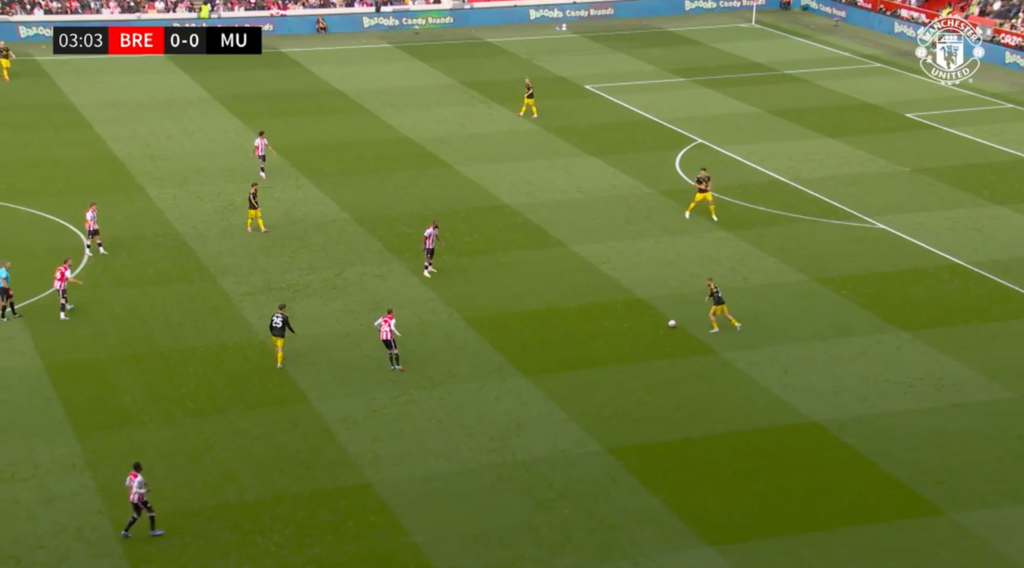
United used their standard 3-2-5 shape on the ball with Bruno Fernandes and Manuel Ugarte in the double pivot. Brentford set-up in a 4-4-2 with some man-to-man oriented aspects.
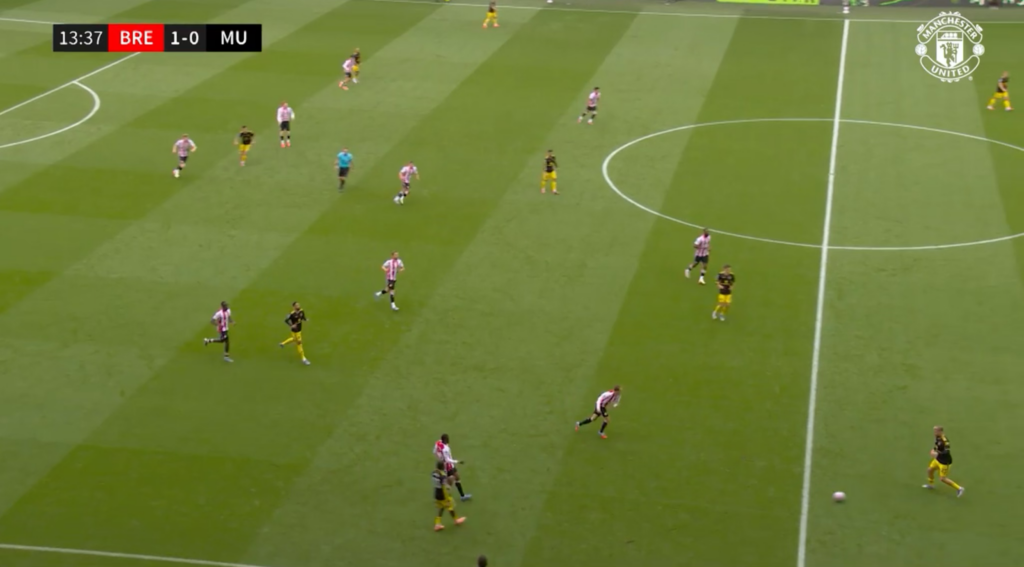
Keith Andrews instructed his right-back, Michael Kayode, to man-mark Matheus Cunha, while Aaron Hickey on the opposite side was given the same task with Bryan Mbeumo. This meant that Brentford’s wingers were responsible for tracking the runs of United’s wing-backs.
Brentford, under Thomas Frank, were a fantastic pressing team. They often went man-to-man and were exceptionally well coached. It was therefore reasonable to adopt a more direct approach against them, especially if you’ve got a target man upfront like United do in Benjamin Šeško.
Brentford under Keith Andrews are entirely different, though. They are far more passive off the ball and sit in a mid-block; they don’t get much pressure on the ball. They rank 18th in the league for high turnovers, averaging 2.3 turnovers per 90 minutes. Last season, they were 4th with 5 per 90.
It is, therefore, incomprehensible that Amorim decided to play long balls instead of playing out from the back. Kobbie Mainoo would’ve actually suited this type of opposition perfectly. In this game, he could’ve easily played alongside Bruno Fernandes because in a game like this, United should be dominating the ball.
If Casemiro wasn’t suspended, the argument could’ve been made that he should play because Brentford are a threat from set-pieces and he offers a commanding presence in the air. A valid argument, it must be said.
However, there is absolutely no reason that Manuel Ugarte should’ve started this game ahead of Mainoo. The game was there for United to take it by the scruff of the neck and stamp their authority on it. Having a ‘controller’ like Mainoo would’ve therefore been a far more logical choice than a ‘destroyer’ like Ugarte.
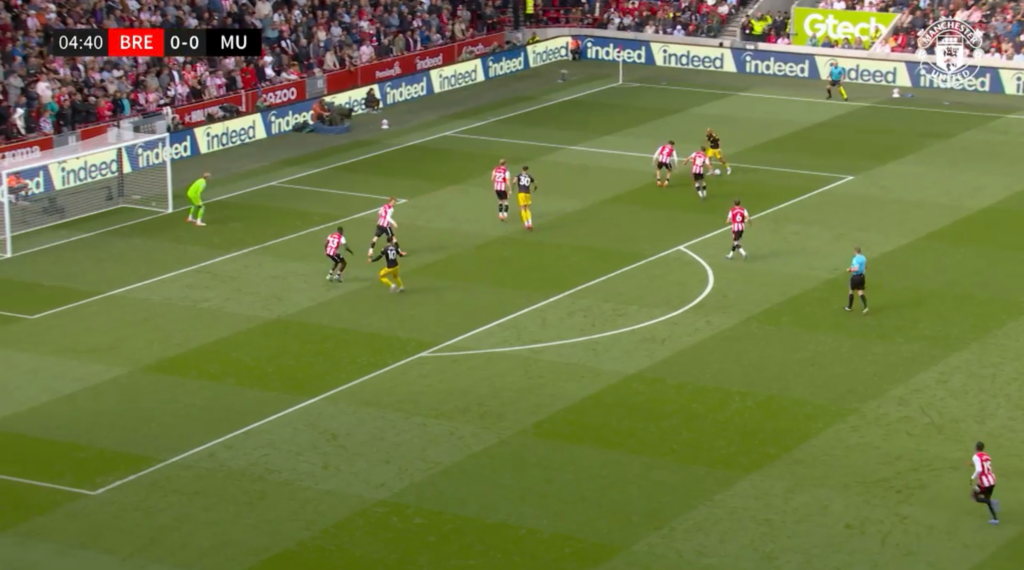
In the image above, United were in Brentford’s box after Harry Maguire won the ball back in United’s half. As you can see, though, it’s a 3v6 situation in Brentford’s favour. When you start six defensive-minded outfield players, this is what happens in attacking transitions.
It happens so often that Amorim starts two full-backs at wing-back, and United always look less threatening when he does that. At least one of the wing-backs has to be a winger.
United’s off-ball approach was no better
This is the part where the players have to take a large portion, although Amorim isn’t blameless.
There’s no need to talk about the first goal too much. It’s clear what happens. It’s a really poor error from Maguire. He jumps up too late and leaves Igor Thiago onside.
Contrary to popular belief, Diogo Dalot is a top player. However, the role of a wing-back maximises almost none of his strengths and amplifies all of his weaknesses. That being said, for the second-goal, it’s hard to imagine what exactly he was thinking.
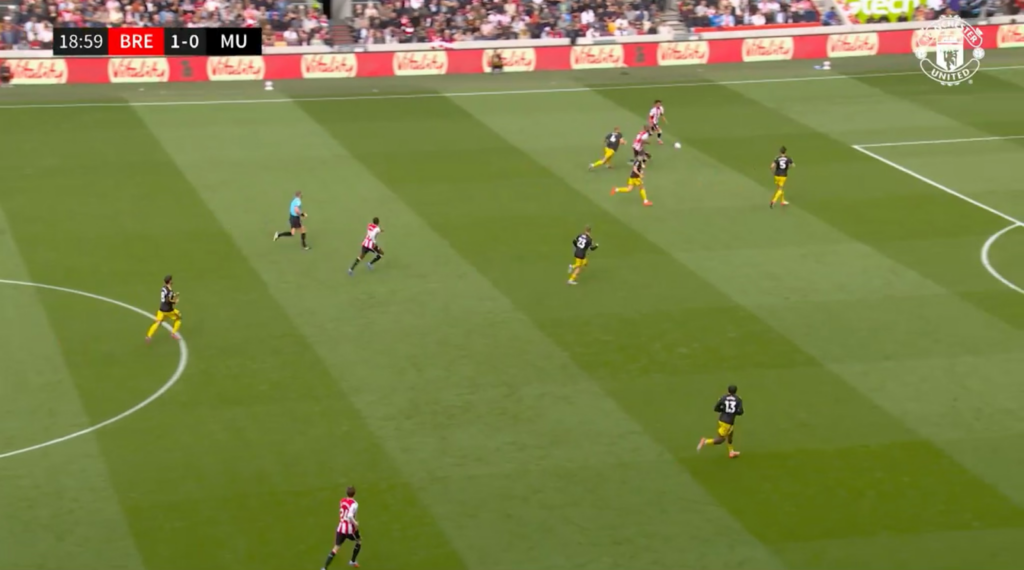
Brentford played a long-ball. Igor Thiago beat Matthijs de Ligt in the aerial duel, and Kevin Schade then got the ball. At this point, De Ligt is left in a 2v1 situation because instead of tracking Schade’s run, Dalot, for some bizarre reason, decided to move more centrally.
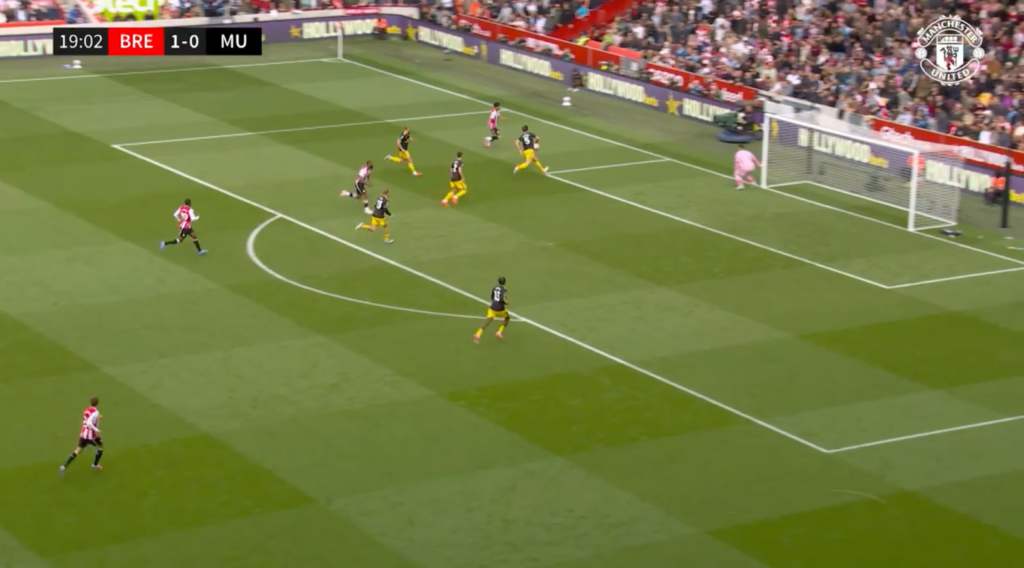
Schade then burst past De Ligt, which then forced Maguire to cover him. That then left a massive empty space in the box, which Igor Thiago ran into and tapped it in to make it 2-0. Luke Shaw tried to track Thiago’s run, but couldn’t, and Dalot likely didn’t even realise the Brentford striker was behind him.
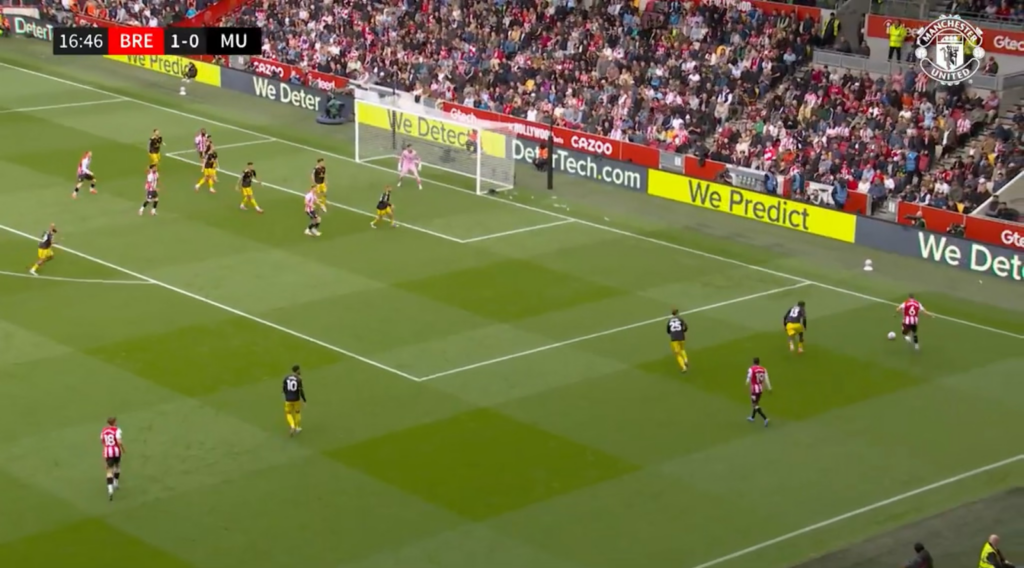
Here is another situation that led to Brentford creating a significant chance. It was a 2v2 out on United’s left. Well, it looked like a 2v2, but it was really a 2v1 in Brentford’s favour. Patrick Dorgu was 1v1 against Dango Ouattara. At that point, Jordan Henderson made an overlapping run.
Henderson excels in that position on the pitch and was regularly deployed by Jürgen Klopp in the area at Liverpool to allow Mohamed Salah to move more centrally.
Manuel Ugarte, in this situation, decided, for whatever reason, not to track Henderson’s overlapping run, which basically left Dorgu in a 2v1 situation. Henderson then put in a superb cross, which would’ve led to a goal had it not been for an impressive save from Bayindir.
United’s press was inconsistent and disjointed
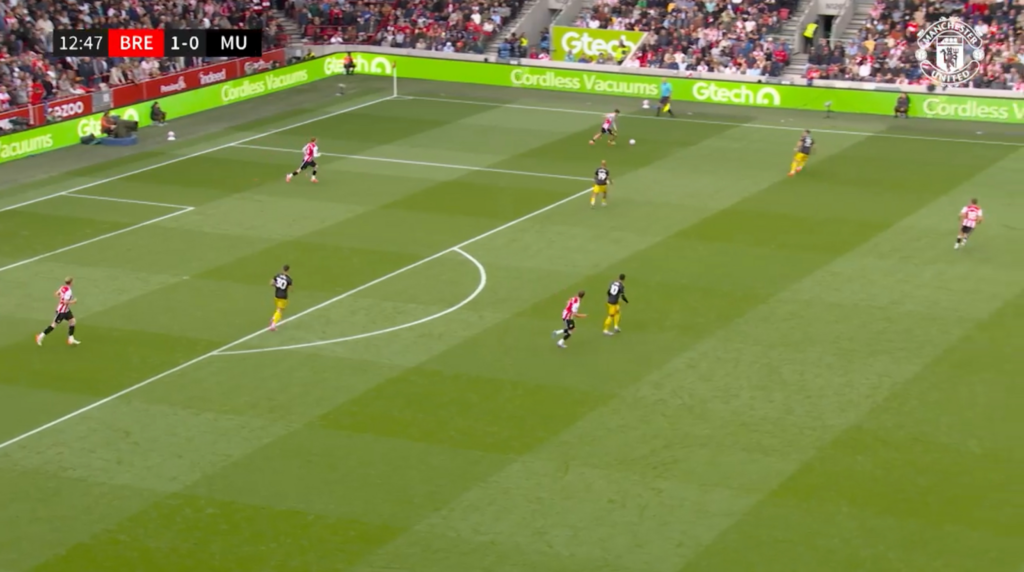
From goal kicks, United adopted a man-to-man approach, one that has worked fairly decently this season, especially with Mason Mount in the team. In the midfield, it was the flawed 5-2-3 shape that every team toys with, as it creates a massive overload.
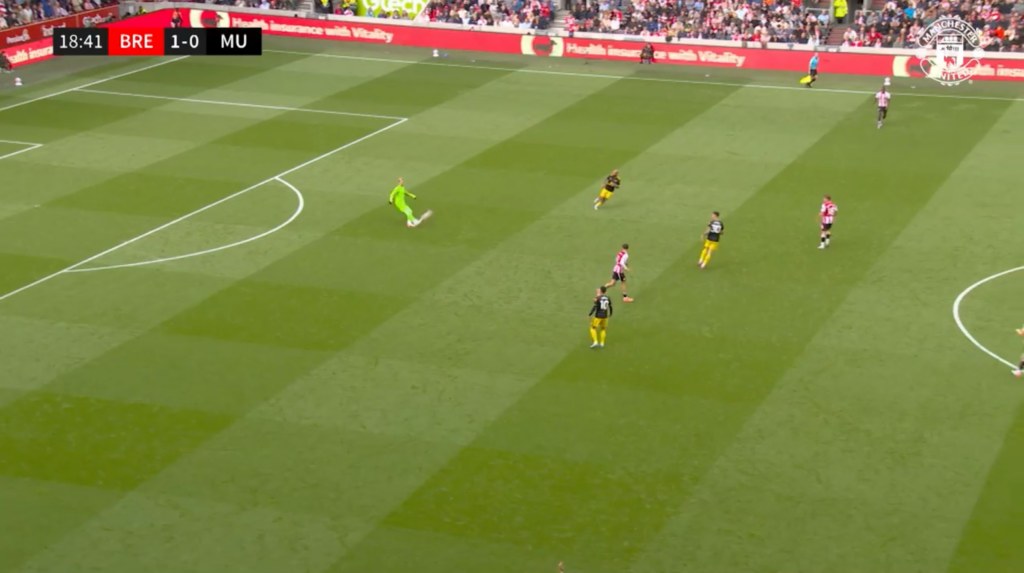
From goal kicks, United have generally been well-organised throughout the season, but they were poor in open play against Brentford.
In the image above, United attempt to go man-to-man, but because of Caoimhin Kelleher, Brentford have a 4v3 overload. Bryan Mbeumo tries to take up a 50/50 position where he closes down Kelleher while blocking the passing lane to Kayode, who’s out on the left-hand side.
He doesn’t get tight enough to Kelleher, though, and that means the keeper can play a chipped pass out to Kayode, and just like that, Brentford have played out of United’s ‘high-press’, if you can even call it that.
Read More: Andoni Iraola’s thoughts on Manchester United move revealed, as “dream opportunity” claim is made
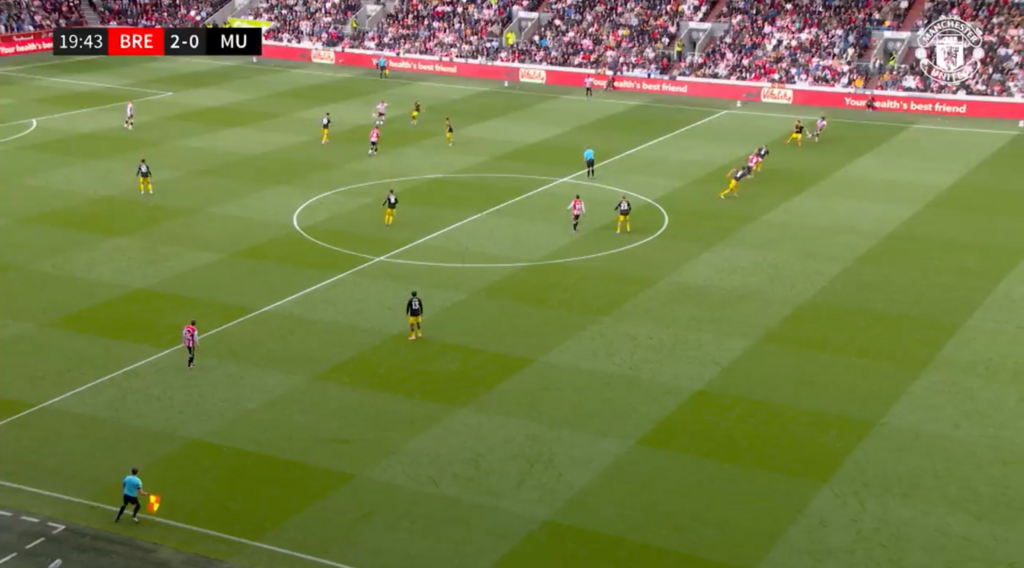
The image above is in the build-up to Brentford’s second goal. In the end, Nathan Collins ended up going long, but United’s set-up here in the press is disgraceful. If there were ever a picture to illustrate how ineffective the 5-2-3 is, it’s this one.
Manuel Ugarte stepped up to mark Jordan Henderson, which in turn left Bruno Fernandes completely isolated in midfield. Ideally, you want the wing-backs to be slightly higher than the centre-backs, but here United have been pinned back in a straight line of five.
It’s Brentford, so they’ll go long most of the time regardless, but against teams who keep the ball and have players who like receiving the ball between the lines, they will destroy you if you leave that much empty space in midfield.
The image above should make it clear to everyone why the 5-2-3 off the ball is such an ineffective setup. You leave yourself so incredibly vulnerable in midfield.
We can discuss all these issues until we’re blue in the face, but Ruben Amorim sees no need to adapt. He sees no need to make even slight tweaks to a system that led United to a 15th-place finish last season.
Unless he suddenly changes, the writing is on the wall for him. It’s a matter of when, not if. And the sooner United make the change, the better.
The players are not blameless, but it’s also hard to judge them in such a dysfunctional setup where almost none of their skill sets are maximised.
For all parties, including Amorim himself, a parting of ways is in the best interest of everyone. The harsh truth is that this project is headed nowhere.
Make sure to follow UtdDistrict on X, Instagram, Facebook, YouTube, and TikTok to never miss out on any of our Manchester United content. Our podcast, What the Devil?, is streamed live every Thursday at 12:30 pm (BST) on the United View YouTube channel.